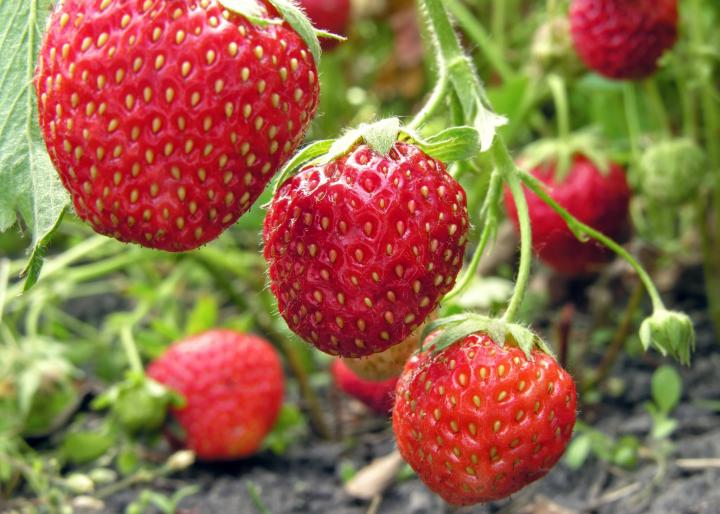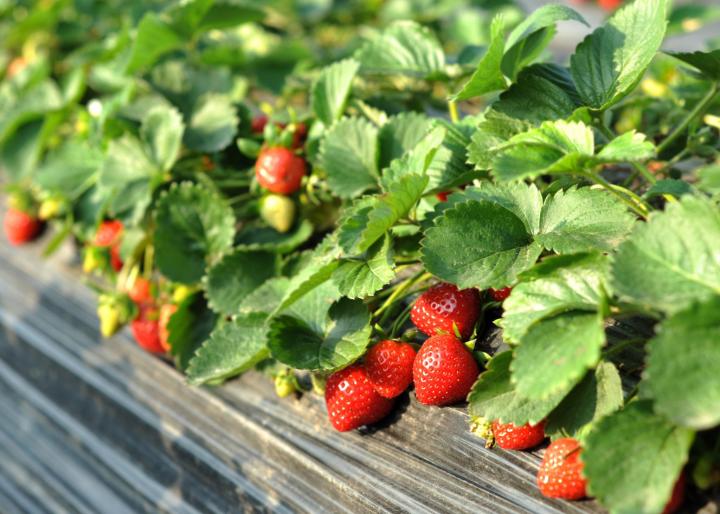Growing, Strawberries
Planting, Growing, and Harvesting Strawberries
Planting, Growing, and Harvesting Strawberries
Sweet, juicy strawberries are treats when right off the
plant. Supermarket berries tend to be tart with a grainy texture
because the natural sugar begins converting to starch as soon as it is
plucked from the plant. It’s definitely worth your while to try growing
strawberries. See how.
The good news is that strawberries are relatively easy to grow if you have full sun.
Strawberry plants come in three types:

Strawberry plants come in three types:
- June-bearing varieties bear all at once usually over a period of 3 weeks. Length-of-day
sensitive, these varieties produce buds in the autumn, flowers and
fruits the following June, and runners during the long days of
summer. Although called June-bearing, these bear earlier than June in
warm climates.
- Everbearing varieties produce a big crop in spring, produce
lightly in the summer, and then bear another crop in late summer/fall. These
varieties form buds during the long days of summer and the short days
of autumn. The summer-formed buds flower and fruit in autumn, and the
autumn-formed buds fruit the following spring.
- Day-Neutral varieties produce fruit continuously through the season until the first frost: Insensitive to day length, these varieties produce buds, fruits and runners continuously if temperature remains between 35 and 85 degrees F (1° to 30°C). Production is less than that of Junebearers.
Planting
Selecting and Preparing a Planting Site
- Strawberry plants require 6-10 hours a day of direct sunlight, so choose your planting site accordingly.
- Strawberries are tolerant of different soil types, although they prefer loam. Ideally, begin working in aged manure or compost a couple months before planting. If you have clay soil, generally mix in 4 inches or more of compost, and rake the clay soil into raised mounds to further improve drainage. If your soil is sandy, simply cultivate to remove weeds, and mix in a 1-inch layer of rich compost or rotted manure.
- Soil pH should be between 5.5 and 7. If necessary, amend your soil in advance of planting. If soils in your area are naturally alkaline, it is best to grow strawberries in half-barrels or other large containers filled with compost-enriched potting soil.
- The planting site must be well-drained. Raised beds are a particularly good option for strawberry plants.
- Practice crop rotation for the most success. Do not plant in a site that recently had strawberries, tomatoes, peppers, or eggplant.
Planting Strawberries
- Plan to plant as soon as the ground can be worked in the Spring. See your local frost dates.
- Buy disease-resistant plants from a reputable nursery, of a variety recommended in your area. Consult with the nursery you buy them from or with your state Cooperative Extension service.
- Roots shouldn’t be longer than 8 inches when plants are set out. Trim them if necessary.
- Provide adequate space for sprawling. Set plants out 20 inches apart to leave room for runners and leave 4 feet between rows. Strawberries are sprawling plants. Seedlings will send out runners, or ‘daughter’ plants, which in turn will send out their own runners.
- Make planting holes deep and wide enough to accommodate the entire root system without bending it. However, don’t plant too deep! The roots should be covered, but the crown should be right at the soil surface. It is very important that you do NOT bury the crown (central growing bud) of the plant or it could rot! The leaves, flowers, and fruit must be exposed to light and fresh air.
- Water in plants well.
- Establish new plants each year to keep berry quality high each season.
- It is also possible to grow strawberries from last year’s runners. See this video to find out how.

Care
How to Grow Strawberries
- Keep the beds mulched to reduce water needs and weed invasion. Any type of mulch – from black plastic to pine straw to shredded leaves – will keep the soil moist and the plants clean.
- Be diligent about weeding. Weed by hand, especially in the first months after planting.
- Moisture is incredibly important due to shallow roots. Water adequately, about one inch per week. Strawberry plants need a lot of water when the runners and flowers are developing and again in the fall when the plants are mature.
- Fertilize with all purpose granules for strong growth. In warm weather, berries ripen about 30 days after blossoms are fertilized.
- In the first year, pick off blossoms to discourage strawberry plants from fruiting. If not allowed to bear fruit, they will spend their food reserves on developing healthy roots. The yields will be much greater in the second year.
- Eliminate daughter plants as needed. First and second generations produce higher yields. Try to keep daughter plants spaced about 10 inches apart.
- When the growing season is over, mow or cut foliage down to one inch and mulch plants about 4 inches deep with straw, pine needles or other organic material. This can be done after the first couple of frosts, or when air temps reach 20°F (-6°C).
- Remove mulch in early spring, after danger of frost has passed.
- Row covers are a good option for protecting blossoms and fruit from birds.
Pests/Diseases
- Gray Mold
- Powdery Mildew
- Japanese Beetles
- Spider Mites
- Slugs
Pest-Beating Tips
- Keeping beds weed-free and using a gritty mulch can deter slugs and bugs. Spread sand over the strawberry bed to deter slugs. (This also works well for lettuce.) Pine needles also foil slug and pill-bug damage.
- For bigger bugs such as Japanese beetles, spray your plants with puréed garlic and neem seed oil.
- When birds threaten your strawberries, position balloons with scare-eyes above the beds and use reflective Mylar bird tape to deter them.
Harvest/Storage
Harvesting and Storing Strawberries
- Fruit is ready for harvesting 4–6 weeks after blossoming.
- Harvest only fully red (ripe) berries, and pick every three days.
- Cut by the stem; do not pull the berry or you could damage the plant.
- For June bearer strawberries, the harvest will last up to 3 weeks. You should have an abundance of berries, depending on the variety.
- Store unwashed berries in the refrigerator for 3–5 days.
- Strawberries can be frozen whole for about 2 months.
- Watch our video on How to Make Strawberry Preserves!

Recommended Varieties
Try planting more than one variety. Each will respond differently to conditions, and you will have a range of different fruits to enjoy.- ‘Northeaster’ is best suited for the northeastern US and southeastern Canada. Fruit has strong flavor and aroma.
- ‘Sable’ is hardy to zone 3, early season, great flavor.
- ‘Primetime’ is a mild-flavored, disease-resistant variety, best adapted to the Mid-Atlantic.
- ‘Cardinal’ is a good variety to try in the South.
- ‘Camarosa’ is a good variety to try on the West Coast.
- ‘Tristar’ is a day-neutral variety that’s very well-suited for hanging baskets


Comments
Post a Comment